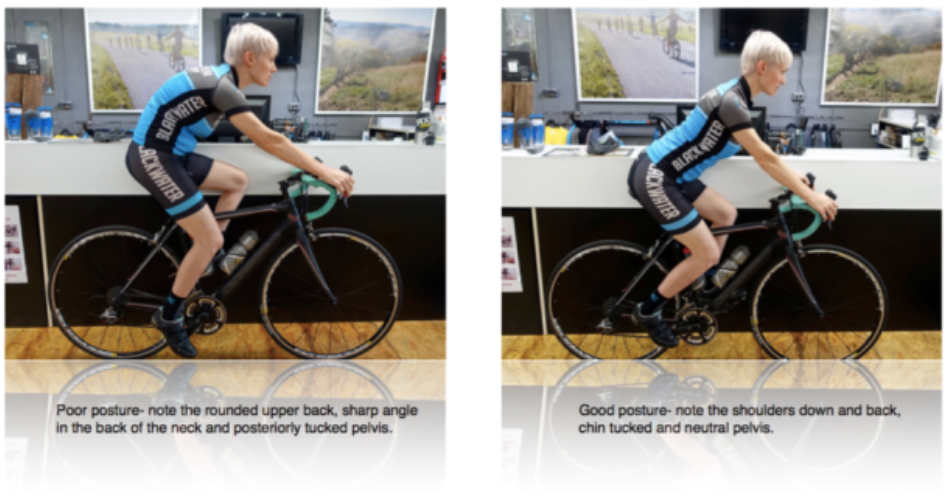 How’s your posture? Right now?
How’s your posture? Right now?
If you are like most you are sitting in a hunched forward position. Your shoulders are rounded forward, head jutting forward squinting at the computer screen (or heaven forbid, reading this on your phone looking straight down, stressing the back of the neck.) Perfect posture on and off the bike can make you a more powerful cyclist and help to prevent neck, shoulder and back pain.
What about your posture on the bike?
For most of us, unless you’re injured or having pain, it doesn’t even get a second thought. When you went to the shop to have your bike fit, were you honest with yourself and your fitter? Did you sit on the bike the way you normally ride, day in and day out, or was the bike fit to a posture perfect you?
The body is basically a fluid frame held together with an elaborate viscoelastic system of pulleys and stabilizers draped over a bony skeleton. There are muscles that contract and relax, ligaments that protect joints, tendons that allow the muscles to attach to the bones, fascia that supports all of the vessels and envelopes the muscles as well as numerous liquids and chemicals that support all of the vital body processes. I haven’t even mentioned the nerves — those electrical conductors that allow us to control, among many things, our posture.
WOW! That sounds kinda GROSS! Truly, the body is amazing!
OK back to the topic at hand, posture. We all need to know what our individual optimal posture is to protect ourselves from pain and dysfunction. We also need it to automatically register in our brain without thinking. It needs to be pre-programmed and easily accessible for the body to settle in on its own while we are riding. Let’s face it, there is enough going on to worry about posture in the middle of a race.
The Self-Assessment
So what exactly is optimal cycling posture? Of course we are all individuals, but there are some guidelines off the bike that we should all strive for.
When standing, look yourself straight in the eye and ask yourself:
- Am I standing with equal weight on both feet so that half of my weight is supported by each leg?
- Am I holding my head off to one side or rotating my head to the right or left?
- Are my shoulders basically level and the same distance from my ears?
- Are my shoulders rounded forward so that my shoulder blades are not optimally sitting flat on my rib cage behind me?
- Are my hips level, is there a soft bend to my knees so that my kneecaps are gently drawn up to support the knee joint?
- Are my shins and kneecaps pointing the same direction and lined up with the center of my ankle and second toe of each foot?
- Are my arches lightly lifted off the floor with all 10 toes pointing forward, with all of my body weight distributed equally between feet as well as around each foot?
Look at yourself from the side in the mirror. Envision a plumb line held at the side of the head that splits the body into a distinct front and back. Ask yourself:
- Does the plumb line drop through the center of my earlobe, center of the shoulder, middle of the hip, middle of the knee and ankle bone all the way down to the floor?
- Is your head sitting squarely on top of your body, not forward stressing your neck and upper back?
- Is your low back naturally arched, not flat and not hyperextended?
That is a lot to register, but this basic standing posture can really point out some power drains to your smooth and efficient cycling posture while on the bike. We all want to use the least amount of energy to move the bike forward toward the finish line. The most economical and efficient transfer of power from our body to the bike, especially in long-distance events is what we all seek.
The power for cycling
This is not all generated from the legs. Think of your legs as pistons that transfer power through your strong core. It is the attachment of your arms and legs to the bike that allows you to deliver the mind-blowing force to the pedals in order to power the bike forward. It is the core that quiets the rocking and “snaking” on the bike, all wasted energy. We want the bike to go forward, not side to side.
Think of the core not only as your abdomen muscles, with all of their layers but also what we call the shoulder girdle and pelvic girdle muscles. Important muscles for cycling also include the lats, rotator cuff, erector spinae, hip flexors and quadratus lumborum, among others. There are textbooks full of these important muscles. More important than all of their names, these muscles function to synchronously help you spin those pedals and remain in good shape to run off the bike too, if triathlon is your sport.
The Length-Tension Relationship of Muscles:
Muscles are complex structures and work best under certain tension at certain lengths. This is where proper posture on the bike comes in. There is a delicate balance in the body between length and strength. Overstretch a muscle in the back of your neck and shoulders by rounding forward, and you will also tighten a muscle in the front of the chest, creating a hunched and inefficient posture. The muscles simply cannot generate the force required to stabilize the arms on the bars to transfer your massive power to the bike. If not at optimal length they are being held at a disadvantage. Too much of this creates a stretch weakness in the upper back and neck and compresses the front of the chest so you cannot draw in the maximum amount of air in the lungs to get enough oxygen to the muscles to power their contractions. This delicate balance exists in the low back and hips also and how you hold your pelvis, whether tucked under you (posteriorly tilted) or less likely arched (anteriorly tilted.)
What does Perfect Posture Look Like?
Proper posture on the bike is more than just sitting up straight; in fact, it takes a little more work than that. This work will pay dividends in power generation and transfer to the bike. On the bike, posture should be comfortable and fluid. The upper torso should be angled forward with minimal pressure on the hands. The pelvis should be neutral. It should not be tilted anteriorly (arched back) or posteriorly (tucked bottom). The legs should be going up and down like pistons straight out of the hip joint. The knees should be flexing and extending with the center of the knee cap over the center of the toes, pointing straight ahead. The shoulder blades should be flat on the back and shoulders down (by isometrically contracting or “setting” the lat muscles.) To assist with this, think about pulling slightly on your handlebars as if you are trying to break them in half or slightly drawing your elbows back toward your knees. Ensure your neck is long and does not have an awkward angle, putting strain on the back of the neck and upper back. Angle your eyes instead of your head to see up the road. Keep your abdominals tight and supporting the spine by thinking of pulling your belly button toward the sky while on the bike. Take frequent mini-movement breaks by shrugging your shoulders, tilting your head from side to side and tilting your pelvis in order to find a neutral position again.
Posture Exercises
Work on these three stretches and three strengthening exercises to allow for perfect posture on the bike, including T,Y and W stretches, side body stretch, hamstring stretch with a strap, single leg bridge, plank variations and shoulder external rotation holds.
Do them 2-3 times a week for improved posture and power on the bike.
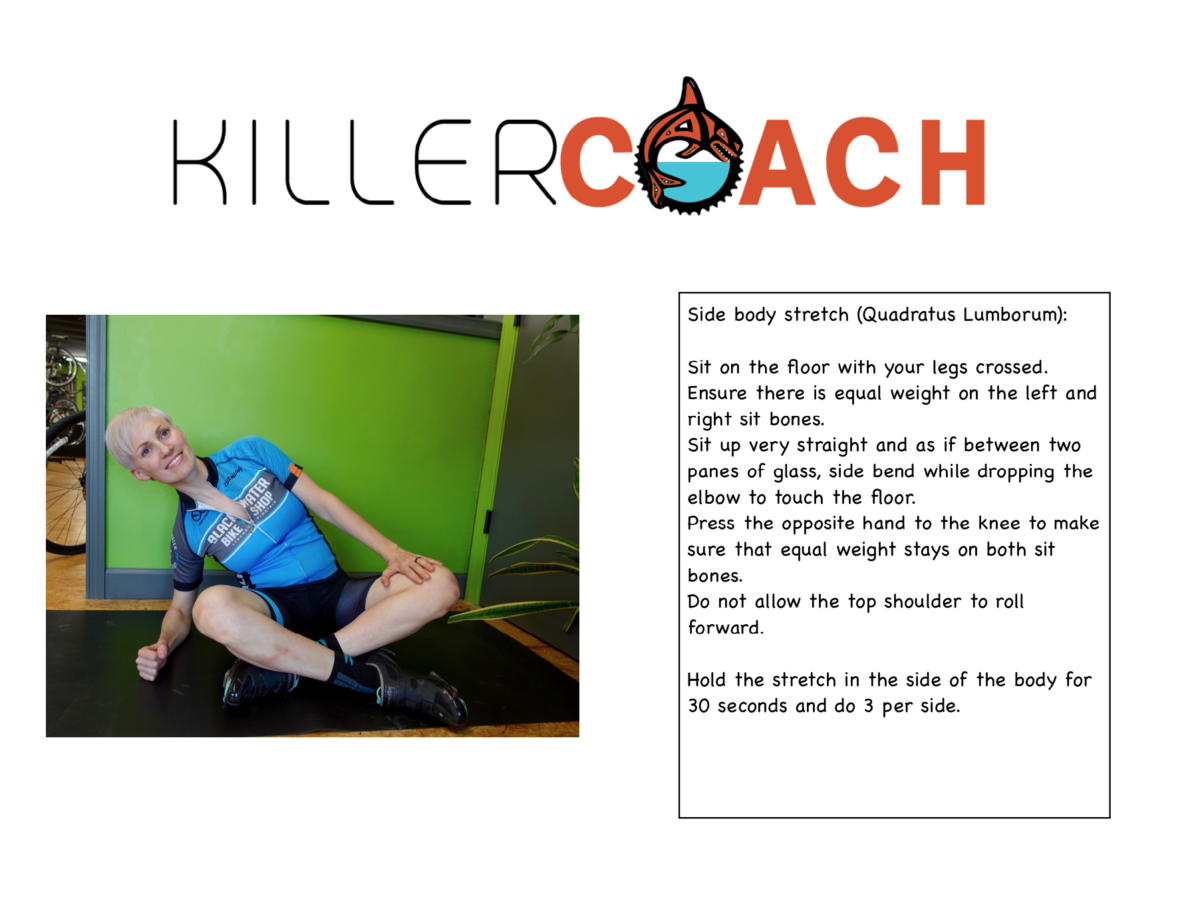

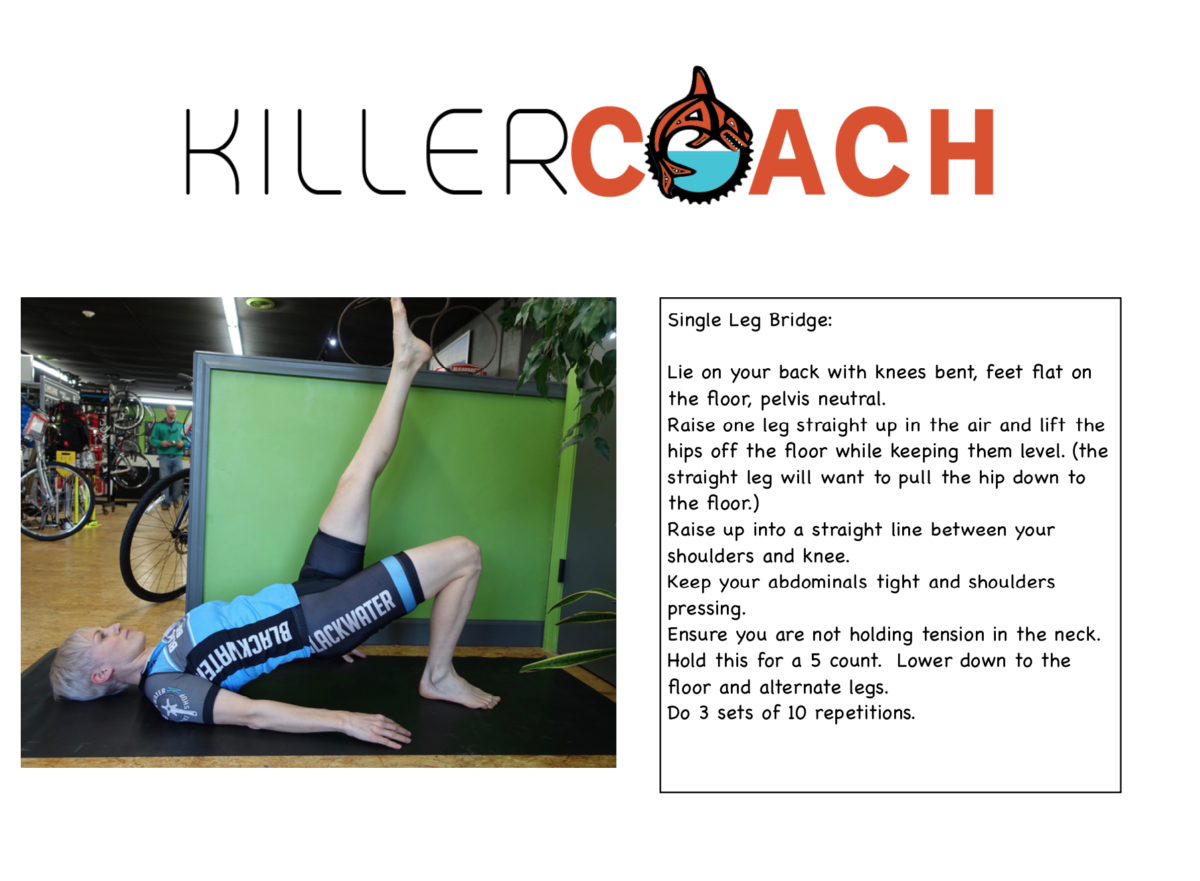
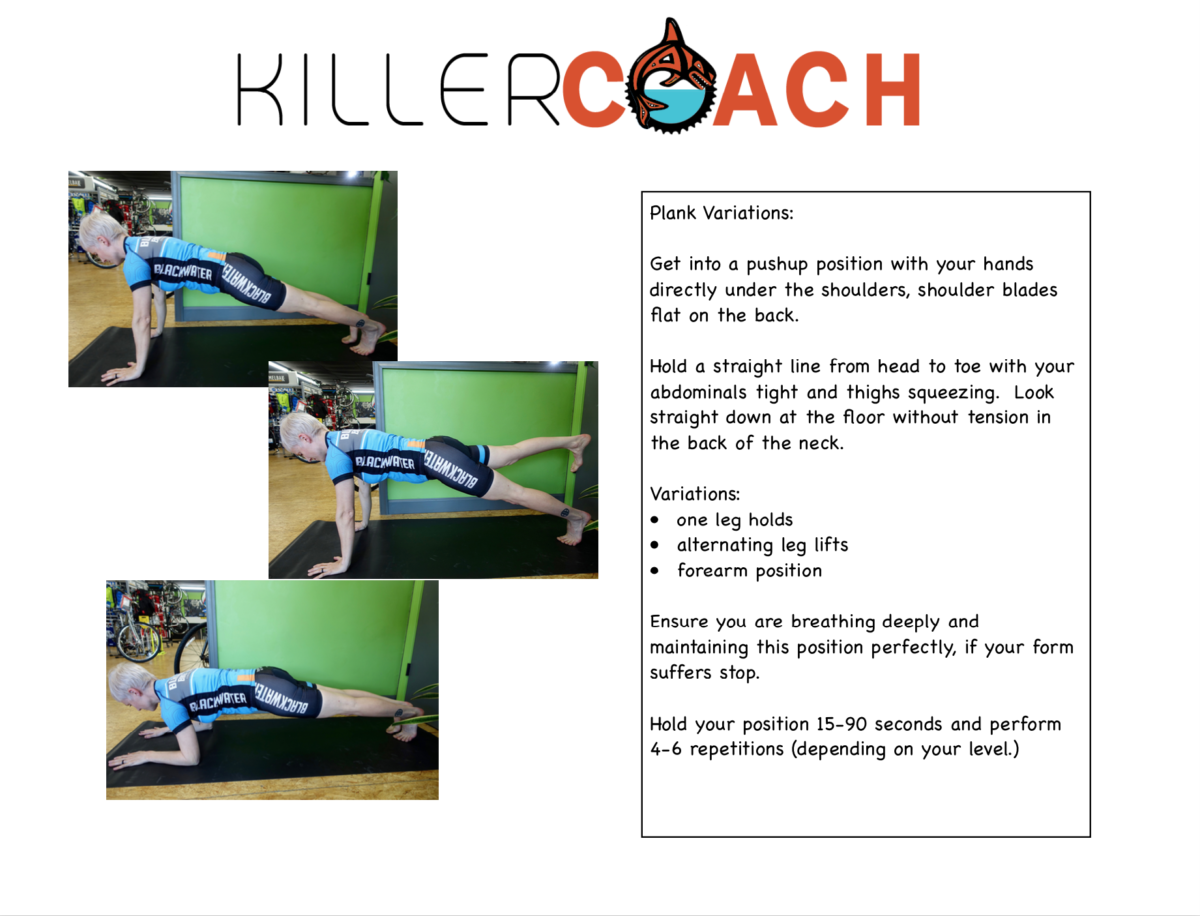
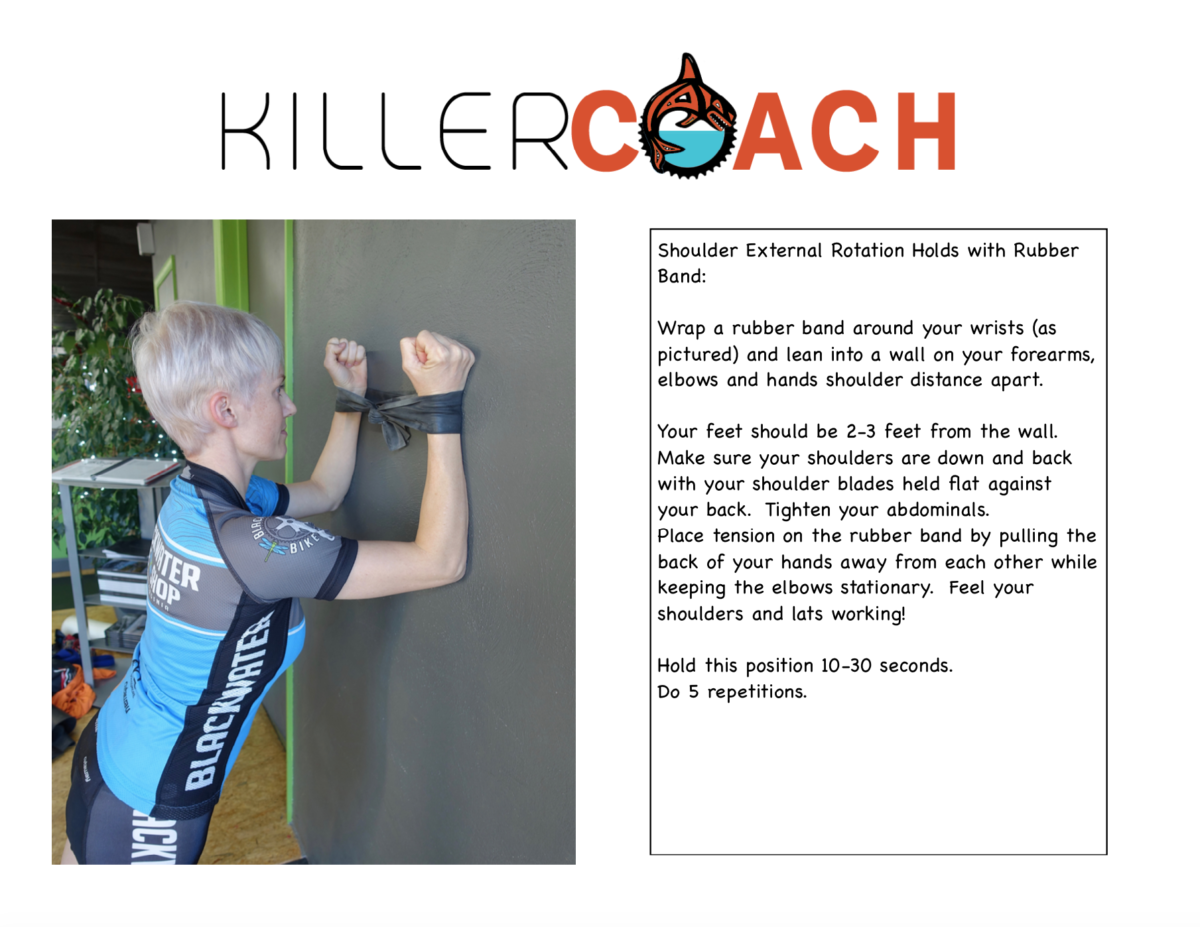
Posture Tips
Postural muscles are primarily slow twitch muscles and are meant to hold your frame up against the pull of gravity all day long. It will take time and constant effort to work these small stability muscles.
1. Practice good posture during the day by:
- Actively sitting at your desk (head long, shoulders down and back, abs engaged, chin tucked) a therapy ball to sit on will ensure you are “sitting actively”).
- Make sure your hips and knees are at 90 degrees in sitting, look straight ahead at your computer screen, forearms supported.
- Move frequently and try not to stay seated for more than 20-30 minutes at a time.
- Set a timer or put a reminder sticker on your computer screen and every time you see it or the timer goes off, get up and stretch or move around.
- Better yet, get a stand-up desk and stand actively, tighten quads and keep a soft bend in the knees, tighten the abs, stand tall with chin tucked and neck long.
2. Get a proper bike fit. Long hours on the bike in one position can lead to knee, low back, hip, shoulder, neck and upper extremity pain, so go see a specialist and get your bike fit to your body.
3. Be aware of muscle spasms, aches and pains. Keep a log and see a biomechanics specialist who knows cycling (physical therapist.) The body will tell you a lot if you listen. Muscle imbalances and muscular firing problems usually develop in characteristic patterns and injury can be avoided if taken care of early.
4. Do not carry a purse or backpack on one shoulder, and try not to stand with more weight on one leg than the other.
5. Perform pro-active strength and stretching exercises two to three times a week to prevent common injuries.
Proper posture on the bike is more than just sitting up straight, in fact, it takes a lot more work than that. This work will pay dividends in power generation and transfer to the bike.
Thanks to Kelly Hazelgrove at Blackwater Bike Shop in Lynchburg,VA for letting us snap photos of her Posture Perfecting Workout!
If you need an awesome MTB Skills session hit up coach Kelly for a sesh!
